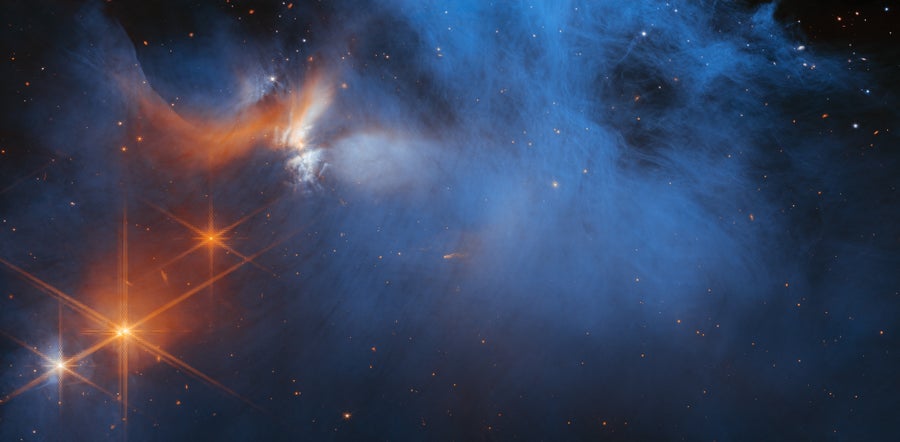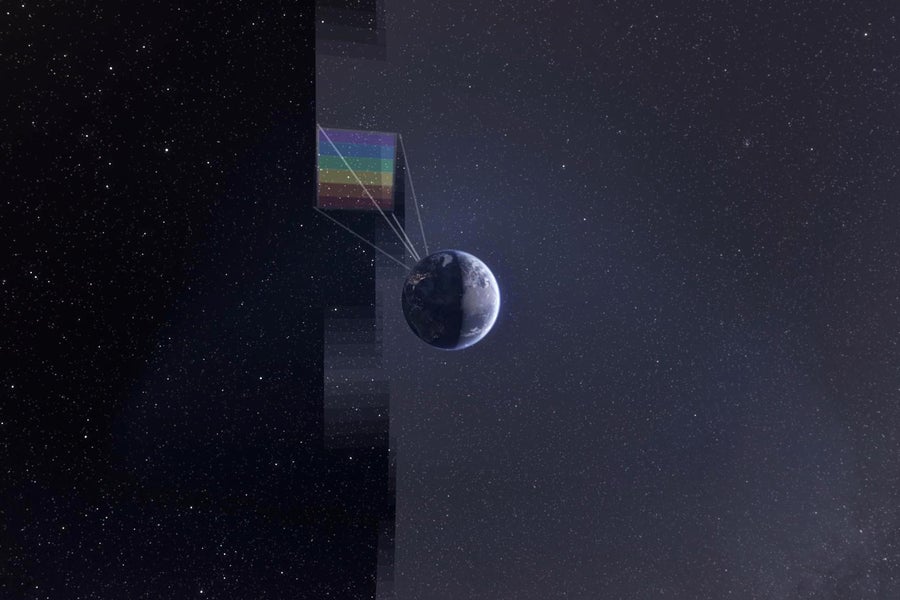NASA is ready to launch a space telescope to see the universe in a whole new way.
The agency’s Spectro-Photometer for the History of the Universe, Epoch of Reionization and Ices Explorer, or SPHEREx, mission, is scheduled to launch no earlier than March 2 at 10:09 P.M. EST from California’s Vandenberg Space Force Base. The $488-million SPHEREx mission is tailored for cosmology; among its key goals is a sort of celestial statistics that scientists hope will help them understand the earliest moments of cosmic history. Once at work, the telescope will survey the entire sky in more than 100 different “colors” of infrared light, creating a massive dataset that will have vast implications across astronomy.
“You don’t normally have a survey like this,” says Jo Dunkley, an astrophysicist at Princeton University, who serves on a NASA review board that is monitoring the mission. “It’s really unusual and really neat.”
On supporting science journalism
If you’re enjoying this article, consider supporting our award-winning journalism by subscribing. By purchasing a subscription you are helping to ensure the future of impactful stories about the discoveries and ideas shaping our world today.
Typically, missions surveying the heavens have wide fields of view but at only a handful of individual or groups of wavelengths of light. Telescopes that can analyze light by its wavelength usually only do so over a small area of sky, pointing at specific objects of interest. For example, the camera on the Vera C. Rubin Observatory in Chile, which is expected to begin observations later this year, will pan the sky in six bands of wavelengths. In contrast, the James Webb Space Telescope has several observing modes that can break light into many wavelengths, but all of them are limited by the observatory’s small field of view.
SPHEREx works differently. To understand it, consider a color printer that breaks an image into one layer each of four different ink colors—cyan, magenta, yellow and black. These colors combine to form a final full-color picture. Similarly, SPHEREx is equipped with six special filters that will split its view of the full sky into 102 infrared colors.
“It’s really mapping the sky in a novel way,” says Olivier Doré, a cosmologist at NASA’s Jet Propulsion Laboratory (JPL) and the California Institute of Technology and a project scientist for SPHEREx. “It’s about opening up a new window on the universe.”
Although the data that the spacecraft gathers will be of broad relevance across all of astronomy, the SPHEREx team has three key science objectives. These range from mapping various ices in and around our galactic neighborhood to tallying all the universe’s light over its history to even probing some of the first moments of time itself, shortly after the big bang.
Ices Galore
In its studies closest to the here and now, SPHEREx will look for assorted ices throughout the Milky Way and its neighboring galaxies. To do so, the telescope will map out the presence of water ice, of course, as well as frozen carbon dioxide, methanol, ammonia and other intriguing compounds. Each of these substances bears its own distinctive molecular signature, or spectrum, which is imprinted in wavelengths of light that interact with it. And scientists will be able to discern these ice spectra with unprecedented clarity thanks to SPHEREx’s observations.
Gathering such spectra has historically been a difficult process; only about 200 such measurements for these ices were made before the launch of JWST. SPHEREx, in contrast, will make some eight million such observations. Scientists hope that the work will provide a better understanding of the complex chemical processes that bond these ices onto interstellar dust grains—and presumably deliver them to nascent planetary systems.

This image by NASA’s James Webb Space Telescope’s Near-Infrared Camera (NIRCam) features the central region of the Chamaeleon I dark molecular cloud, which resides 630 light years away. The cold, wispy cloud material (blue, center) is illuminated in the infrared by the glow of the young, outflowing protostar Ced 110 IRS 4 (orange, upper left).
NASA, ESA, CSA, and M. Zamani (ESA)
“It’s likely the case that the ice in the interstellar medium is the source of water on Earth and in our solar system,” says James Bock, a cosmologist at JPL and the California Institute of Technology and principal investigator of SPHEREx. This is more than some academic triviality, too, given how important these particular molecules are for a little phenomenon we call life.
All the Universe’s Light
Ices aside, much of SPHEREx’s work will concern the earlier, more distant cosmos, thanks to the telescope’s focus on infrared light. Because the universe is constantly expanding in all directions, a wavelength of light traveling through it is literally stretched. Scientists call this phenomenon “redshifting” because, within the range of light human eyes can see, red light has the longest wavelengths. The more space light traverses, the more its wavelength is stretched, and the redder it becomes—so any light emitted from ancient, faraway sources often ends up becoming the infrared light SPHEREx can see.
This also means that careful analysis of an object’s redshifted light allows astronomers to calculate how far away the object is from Earth. Across astronomy, measuring this deepness in the sky adds a third dimension of distance (and of time, thanks to light’s finite speed) onto our otherwise flat maps of the universe.
These tactics are particularly powerful for regions where SPHEREx will gather the most data—upward and downward from the plane of our solar system, within swaths of the sky dubbed the north and south ecliptic poles. The telescope will observe each ecliptic pole once every orbit all mission long, seeking something seemingly ineffable: the faint signal of all the light emitted over the universe’s history, which SPHEREx scientists will then parse out across time.
Researchers have already estimated this cosmic flux by measuring the amount of light generated by representative samples of galaxies. But they know this undercounts the true light production. Some galaxies are too far away or too faint to be measured via this approximation technique, and the light from stars at a galaxy’s diffuse outskirts is easily overlooked. But SPHEREx isn’t gazing at individual galaxies: it’s looking at the whole sky, so it will see even this otherwise missed light lurking in the background.
“Even if you don’t see a star there, we’ll still see the light, the photons collectively emitted by all of the galaxies in the universe,” says Asantha Cooray, a cosmologist at the University of California, Irvine, and a member of the SPHEREx team.
But simply seeing isn’t enough: scientists also want to understand how the universe’s total light production has changed over time, which is where redshifting and SPHEREx’s wavelength-rich data come in. Tracking these temporal changes could help reveal how the first galaxies developed, for example, or how the strange “little red dots” observed by JWST formed mere hundreds of millions of years after the big bang.

Operating from low Earth orbit, SPHEREx will sweep across the sky, taking about 600 exposures each day. Using a technique called spectroscopy, the observatory will image every section of the sky 102 times, each time using a different color filter that blocks all wavelengths except one.
“Each wavelength is kind of giving you a different slice through cosmic history,” Bock says. It’s as if the four-color image of our “printer” analogy exploded out into a series of distinct layers between the viewer and the page—with each more distant layer being significantly older than the one in front of it, encoding billions of years of history in their transitions.
“We are trying to probe pretty much all the whole cosmic history, all the way to the epoch of first star formation,” Cooray says.
Zooming In on Inflation
The last of SPHEREx’s primary science goals looks even further back in time, all the way to the moments after the big bang, during which most scientists believe that a phenomenon called cosmic inflation drove an explosive increase in the universe’s size.
“Inflation was a big event in our universe,” Bock says. “It expanded the universe dramatically—a trillion-trillion-fold or something like that.”
For something so epochal, inflation is surprisingly hard to study. It happened when the universe’s matter was in an almost inconceivably dense, energetic state, well beyond anything scientists can attempt to mimic in a laboratory. SPHEREx won’t change those constraints, but it will allow scientists to pursue a roundabout way of understanding how inflation unfolded.
“It’s really a discovery machine.” —Olivier Doré, cosmologist
At the heart of this work is SPHEREx’s survey of the entire sky and many of the galaxies in it—some 450 million, all told. The telescope will pinpoint the location of each of these galaxies, creating a massive three-dimensional atlas of the cosmos.
From there will come the celestial statistics. Based on different theories about how inflation might work and what other phenomena might affect it, scientists have developed different models of how matter would have been scattered across the newborn universe. Despite the intervening eons, this pattern should still be etched across the cosmos in the spatial distributions of galaxies. And SPHEREx should provide the data needed to detect it, evaluating which inflationary models it fits and which it doesn’t—supporting some inflation scenarios and refuting others, even without observing inflation directly.
“We are intellectually going back in time to the origin of the universe,” Doré says. “We can actually, pretty much with pen on paper, go from the distribution of galaxies on these larger scales, using physics we know, all the way to the physics of inflation. That’s something which is very powerful, very mind-boggling.”
During its initial journey away from Earth, SPHEREx is also facilitating scientists’ understanding of the sun. A second NASA mission, composed of four small satellites collectively called Polarimeter to Unify the Corona and Heliosphere, or PUNCH, will hitch a ride with the space telescope. Like SPHEREx, these four satellites will orbit Earth along the line where day meets night. But unlike their larger cosmos-focused companion, the PUNCH satellites will look toward our star, studying how its outer atmosphere feeds the stream of charged particles called the solar wind that suffuses our entire solar system.
But even SPHEREx proper will contribute to science far beyond its three primary astronomy questions. Although it is tailored to peer into the distance, for example, it will nonetheless observe everything that falls in its path, including nearer oddities such as planets, asteroids and comets. And because it will survey the full sky at least four times—quite possibly more, given NASA’s record of wringing as much science as possible from its spacecraft—researchers interested in quickly-changing events such as supernovas will also seek fresh finds in SPHEREx data.
“The beauty of astronomy is: we know that every time we look at the sky in a different way, with a different instrument, from a different angle, we discover new things,” Doré says. SPHEREx will simply be the newest iteration of this truism, he adds. “It’s really a discovery machine,” Doré says.








Leave a Comment